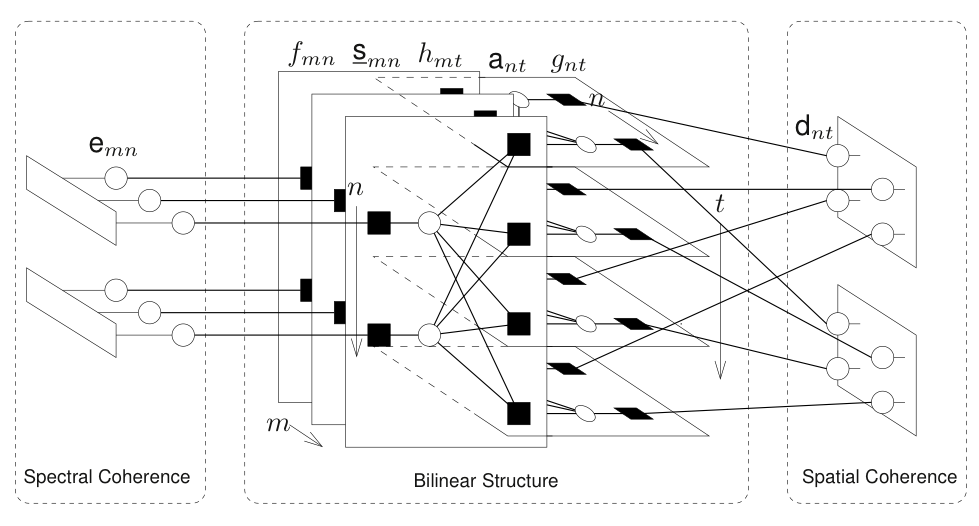HUT-AMP: Hyperspectral Unmixing via Turbo Approximate Message Passing
Overview
The Hyperspectral Unmixing via Turbo Approximate message passing (HUT-AMP) algorithm is an empirical-Bayes algorithm that performs joint recovery of the radiance spectra and per-pixel abundances given measurements \( \boldsymbol{Y} \in \mathbb{R}^{M \times T} \). We assume linear mixing, i.e., \(\boldsymbol{Y} = \boldsymbol{SA} + \boldsymbol{W},\) where the nth column of \( \boldsymbol{S} \in \mathbb{R}_+^{M \times N} \) is the spectra, or endmember, of the nth material, the corresponding row of \( \boldsymbol{A} \in \mathbb{R}_+^{N \times T} \) are the per-pixel abundances, and \( \boldsymbol{W} \) represents noise.
In addition, we assume additional structure on the signal model. First, we assume that the amplitudes of each material's spectra are correlated across wavelength, an aspect we call spectral coherence. Next, we assume that each material's abundances are not only sparse, but that the sparsity pattern is structured across the 2-D scene, an aspect we call spatial coherence. To promote these spatial and spectral coherence structures in our empirical-Bayes algorithm, we introduce auxiliary random vectors, and assume a Gauss-Markov chain and Markov random field model, respectively, on each of them.
To perform inference on the endmembers and abundances, we perform loopy belief propogation on the underlying factor graph (illustrated in the top right). We separate the spectral coherence, spatial coherence, and bilinear structure tasks as three different sub-blocks. Belief propagation is performed on the spectral and spatial coherence in a straightforward manner. For the bilinear structure sub-block, we use the Bilinear Generalized Approximate Message Passing algorithm. We then exchange messages between sub-blocks using turbo approximate message passing.
Advantages of HUT-AMP
We highlight some of HUT-AMP's advantages below:
- HUT-AMP performs the unmixing task jointly without relying on the pure-pixel assumption.
- HUT-AMP promotes know spectral and spatial coherence structures.
- All parameters that describe the Bayesian distributions are learned via expectation-maximization from the data.
- HUT-AMP has a model order selection strategy to automatically estimate the number of materials.
Matlab code
The HUT-AMP MATLAB function attempts to recover the endmember and abundances via the hyperspectral data. In addition, HUT-AMP has some optional inputs to improve computation time/accuracy, along with toggles for learning of the prior's parameters.
Contact List
Please contact the following authors regarding any questions:
- Jeremy Vila (OSU) - Email: vilaj@ece.osu.edu
- Phil Schniter (OSU) - Email: schniter@ece.osu.edu
Publications
The details are in:
Full Paper
- J. Vila, P. Schniter, and J. Meola, ``Hyperspectral Unmixing via Turbo Bilinear Approximate Message Passing [arxiv].''
Conference
- J. Vila, P. Schniter, and J. Meola, ``Hyperspectral Image Unmixing via Bilinear Generalized Approximate Message Passing [pdf],'' Proc. SPIE Defense, Security, and Sensing, (Baltimore, MD), Apr. 2013. [slides]
Support
This work has been supported in part by NSF grants IIP-0968910, CCF-1018368, and CCF-1218754, and by an allocation of computing time from the Ohio Supercomputer Center
Hit Web Counter
© 2015 Jeremy Vila
Template design by Andreas Viklund

